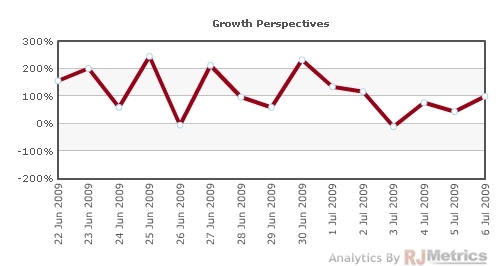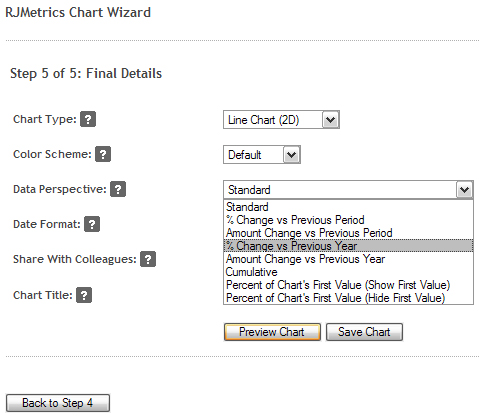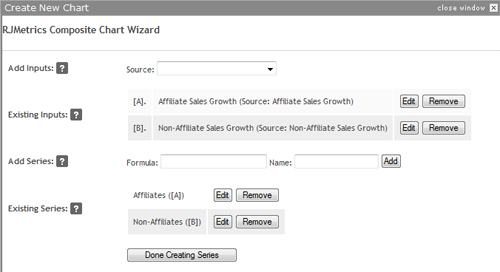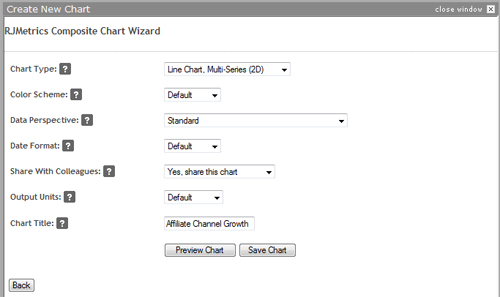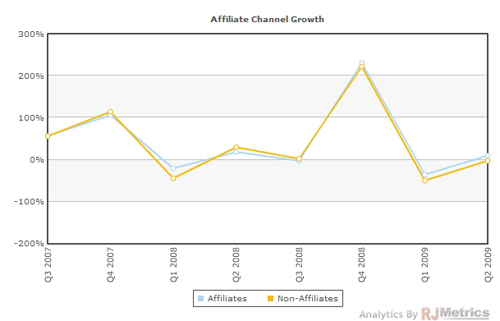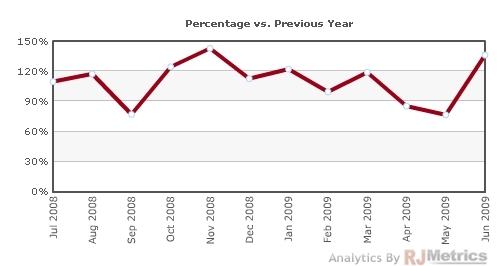RJMetrics’s Growth Perspectives are a powerful tool for easily comparing the value of a particular trend from one period of time to another. These perspectives work within all of the existing RJMetrics time constructs, including hours, days, weeks, months, quarters, and years.
There are two main ways of viewing growth over time: period-over-period (shown as “Change vs. Previous Period”) and year-over-year (shown as “Change vs Previous Year”). These options can be accessed from Step 5 of the RJMetrics Chart Wizard, as shown below.
Read on for a detailed look at each perspective type.
Previous Period
When using the “vs. Previous Period” option, RJMetrics will display comparison results based on whatever period is being used to display time on the x-axis. For example, if you are showing monthly data on the x-axis, each value will represent the change from the previous month. If you are viewing data by hour, you will see how the chart’s values change each hour as compared to the previous hour, and so forth.
There are two options for comparing period-over-period data: by percent (“% Change vs. Previous Period”) and by value (“Amount Change vs. Previous Period”). Examples of each type of output are shown below:
Previous Year
The “vs. Previous Year” options allow users to compare a chart’s data points against the same period in the previous year. As with the “vs. Previous Period” perspectives, users are given the choice of seeing the percentage change (“% Change vs. Previous Year”) or the actual amount difference as compared to the same period in the previous year.
Nuances
Note that if “Year” is the time interval selected for the x-axis, the “previous period” and “previous year” comparisons are functionally equivalent. Because of this, only the “previous year” option is displayed when annual data is being shown on the x-axis.
Additionally, note that you can view a “previous period” or “previous year” metric even if time isn’t on the x-axis at all. As long as an explicit time period has been selected, you can use these perspectives to view a comparison to that same time period one year ago or a time period of equal length immediately preceeding the chosen period (via year-over-year and period-over-period perspectives, respectively).
Also noteworthy is how these perspectives respond to insufficient data. Obviously, a comparison to a previous period can only be made if data for that previous period exists. In instances where the comparison requires data that stretches before the earliest date in the data set, the output is automatically clipped so that it begins at the earliest period when a comparison can actually be made.
Finally, there is a special nuance that comes into play when comparing day-to-day data on a year-over-year basis. One might think that the best way to make such a comparison is by simply comparing, say, July 11, 2009 to July 11, 2008. However, this doesn’t do a good job of accounting for weekly seasonality because July 11, 2008 fell on a Friday while July 11, 2009 falls on a Saturday.
While such a comparison could technically be considered correct because it compares the same calendar day year-over-year, we view it as a metric of little value. If your business does significantly different sales on weekends than weekdays, for example, this comparison will show an artificial year-over-year drop or leap, skewing your understanding of growth.
A far more valuable comparison is made by looking at the closest same day of the week from the previous year, even if that day of the week happens to fall on a different calendar day. The way to accomplish this is to make year-over-year date comparisons by comparing to the day exactly 364 days prior to the day in question (since 364 is perfectly divisible by 7). This is how RJMetrics makes such comparisons. We view it as a vastly superior method for comparing one-day intervals on a year-over-year basis, however unintuitive it might be at first glance. (This also prevents any issues with comparisons involving leap years.)
Of course, if you have some legitimate reason for wanting to see a percentage comparison of the same exact calendar date, this can still be accomplished using composite charts.
We hope these new perspectives will provide another helpful way of tapping into the value of your company’s data via RJMetrics.

